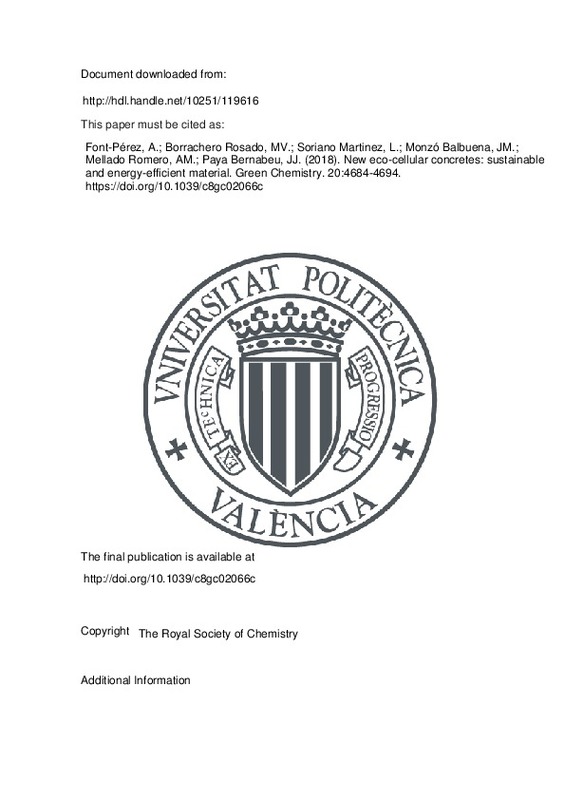JavaScript is disabled for your browser. Some features of this site may not work without it.
Buscar en RiuNet
Listar
Mi cuenta
Estadísticas
Ayuda RiuNet
Admin. UPV
New eco-cellular concretes: sustainable and energy-efficient material
Mostrar el registro sencillo del ítem
Ficheros en el ítem
| dc.contributor.author | Font-Pérez, Alba
|
es_ES |
| dc.contributor.author | Borrachero Rosado, María Victoria
|
es_ES |
| dc.contributor.author | Soriano Martinez, Lourdes
|
es_ES |
| dc.contributor.author | Monzó Balbuena, José Mª
|
es_ES |
| dc.contributor.author | Mellado Romero, Ana María
|
es_ES |
| dc.contributor.author | Paya Bernabeu, Jorge Juan
|
es_ES |
| dc.date.accessioned | 2019-04-27T20:38:37Z | |
| dc.date.available | 2019-04-27T20:38:37Z | |
| dc.date.issued | 2018 | es_ES |
| dc.identifier.issn | 1463-9262 | es_ES |
| dc.identifier.uri | http://hdl.handle.net/10251/119616 | |
| dc.description.abstract | [EN] Chemistry is an essential science for understanding and developing construction materials. Specifically, the application of the green chemistry concept to the cement sector may allow the fabrication of new environmentally friendly materials with good sustainability and energy efficiency. Cellular concretes are an excellent alternative to conventional concrete in terms of thermal insulation and material economy. In this paper, the development of waste-based cellular concrete is presented; due to its good performance and low environmental impact, this focus is warranted. Three different cellular concrete systems were investigated: (i) traditional cellular concrete based on ordinary Portland cement and commercial aluminium powder; (ii) geopolymer cellular concrete applying alkali-activated chemical technology with a comparison of the use of two precursors, fluid catalytic cracking catalyst residue (FCC) and blast furnace slag (BFS), and recycled aluminium foil as an aerating agent; (iii) eco-cellular concrete, where commercial waterglass was replaced by an agro-industrial by-product, rice husk ash (RHA), in the activating solution. The development of geopolymer cellular concretes with different precursors and activating solutions has proven that the production of this type of concrete using different types of precursors is possible, depending on the availability of by-products and wastes. The densities, compressive strengths, and thermal properties of the three cellular concrete systems are assessed and a complete study on the carbon footprints of the developed concretes is presented. The results show that the alternative concretes have densities from 474 to 813 kg m¿3 , with compressive strengths from 2.6 to 4.6 MPa and thermal conductivities from 0.083 to 0.281 W m¿1 K¿1. In the case of the cellular concrete prepared using RHA in the activating reagent, the heat released from the dissolution of NaOH pellets in water dissolved the soluble silica present in the ash. This production method resulted in a reduction of its carbon footprint by 78%. | es_ES |
| dc.description.sponsorship | The authors acknowledge financial support from the Universitat Politecnica de Valencia (UPV) through the internal project GEOCELPLUS. The authors would also like to express special gratitude to Dr Mrs Josefa L. Rosello Caselles for the recycled aluminium foil and to the Electronic Microscopy Service of the UPV. Thanks are given to DACSA, Cementval and BPOil for supplying samples. | |
| dc.language | Inglés | es_ES |
| dc.publisher | The Royal Society of Chemistry | es_ES |
| dc.relation.ispartof | Green Chemistry | es_ES |
| dc.rights | Reserva de todos los derechos | es_ES |
| dc.subject | Electron Microscopy Service of the UPV | es_ES |
| dc.subject.classification | INGENIERIA DE LA CONSTRUCCION | es_ES |
| dc.title | New eco-cellular concretes: sustainable and energy-efficient material | es_ES |
| dc.type | Artículo | es_ES |
| dc.identifier.doi | 10.1039/c8gc02066c | es_ES |
| dc.relation.projectID | info:eu-repo/grantAgreement/MINECO//BIA2015-70107-R/ES/APLICACIONES DE SISTEMAS GEOPOLIMERICOS OBTENIDOS A PARTIR DE MEZCLAS DE RESIDUOS: MORTEROS,HORMIGONES Y ESTABILIZACION DE SUELOS/ | es_ES |
| dc.rights.accessRights | Abierto | es_ES |
| dc.contributor.affiliation | Universitat Politècnica de València. Departamento de Ingeniería de la Construcción y de Proyectos de Ingeniería Civil - Departament d'Enginyeria de la Construcció i de Projectes d'Enginyeria Civil | es_ES |
| dc.description.bibliographicCitation | Font-Pérez, A.; Borrachero Rosado, MV.; Soriano Martinez, L.; Monzó Balbuena, JM.; Mellado Romero, AM.; Paya Bernabeu, JJ. (2018). New eco-cellular concretes: sustainable and energy-efficient material. Green Chemistry. 20:4684-4694. https://doi.org/10.1039/c8gc02066c | es_ES |
| dc.description.accrualMethod | S | es_ES |
| dc.relation.publisherversion | http://doi.org/10.1039/c8gc02066c | es_ES |
| dc.description.upvformatpinicio | 4684 | es_ES |
| dc.description.upvformatpfin | 4694 | es_ES |
| dc.type.version | info:eu-repo/semantics/publishedVersion | es_ES |
| dc.description.volume | 20 | es_ES |
| dc.relation.pasarela | S\374512 | es_ES |
| dc.contributor.funder | Ministerio de Economía y Empresa | es_ES |







![[Cerrado]](/themes/UPV/images/candado.png)

